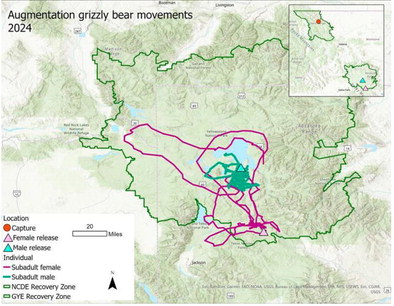Yellowstone Bears Explore New Territory After Transplant


A new map illustrates bear movements into new territory in Yellowstone National Park. According to Montana Fish, Wildlife and Parks, the lines on the map look like the doodling of a toddler. The pink line makes big loops that sometimes overlap. The green line is wound so tightly, it just looks like a big blob. Though they sometimes get close to each other, they seldom intersect.
The lines show the movements of the female grizzly bear (pink larger loops) and male grizzly bear (green more overlapping trail in center) that were relocated from the Northern Continental Divide Ecosystem to the Greater Yellowstone Ecosystem this past summer. Both ecosystems have populations of grizzly bears that have surpassed recovery goals. However, the translocation effort was designed to help increase the genetic diversity of the GYE population, which has been isolated from nearby populations for many years. It’s an effort that may be repeated in the future, depending on how close the two populations eventually grow.
“This just jump starts what very likely will also happen naturally,” said Ken McDonald, head of Montana Fish, Wildlife & Parks’ Wildlife Division.
The bears were captured and collared within a day of each other southwest of east Glacier in a remote area of the Middle Fork of the Flathead River drainage in July and driven overnight to the GYE. One was a 3- to 4-yearold female; the other was a 4to 5-year- old male.
“We were looking for the ideal bears,” McDonald said. “It’s actually not that easy to capture two bears that are prime candidates for translocation.”
In this case, the ideal bears were subadult, meaning they were older than cubs but not at sexual maturity yet, had no history of conflict and weighed enough to prepare for hibernation, McDonald said. Bears of this age are often in search of their permanent home range, therefore they are more likely to stay in the relocation than more mature individuals.
FWP worked with partners from the National Park Service and the Wyoming Game and Fish Department on the translocation destinations. The male bear was hauled by boat to the southern end of Yellowstone Lake. The female was taken to a remote location in the Blackrock Creek drainage west of Dubois, Wyo.
“We are very pleased to see that both bears have remained in the GYE, even staying mostly within remote areas of the Recovery Zone,” said Cecily Costello, FWP grizzly bear researcher. “It’s not always easy for a bear to adjust after being moved like this, but they seem to be settling in. We believe both have recently found a den site for the winter.”
Population recovery levels in the NCDE and GYE were passed several years ago. Montana has petitioned the U.S. Fish and Wildlife Service to delist bears in the NCDE, and Wyoming, with support from Montana and Idaho, has In both ecosystems, the states have met the delisting requirements and addressed concerns identified by the public or lined out by federal courts that have overturned previous delisting efforts. Those elements include: reaching population recovery, having conflict prevention and response programs in place, continuing with research and monitoring, establishing a regulatory framework for managing grizzly bears once delisted, continuing with education and outreach about grizzly bears, safeguarding genetic health.
According to McDonald, Montana and Wyoming have and will continue to act on their commitment to connectivity, and the agencies will continue to monitor the bears and their genetics to check for population diversity.
“That these bears are exploring their new ecosystem and seem to be doing well is an indication that they’ll thrive in their new environment,” McDonald said. “It also reflects the commitment Montana has to grizzly bear conservation.”

